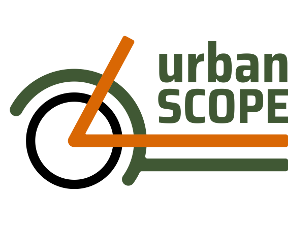Read here the latest news on the UrbanSCOPE Learning Methodology and digital tools!
The concept of Sustainable Urban Mobility Plan (SUMP) was developed by the European Commission, in order to facilitate European cities to move towards sustainability. These documents are planning tools for cities that bring together different sectors and stakeholders in order to improve the mobility of the urban environment. Although the primal target groups of integrated mobility plans are the policy makers, professionals and authorities of the cities, it is extremely important to introduce these concepts in education. By making students of different education level familiar with SUMPs, we do not only train future professionals, but also raise responsible citizens, who will be more tolerant towards sustainable urban mobility modes.
The aim of the UrbanSCOPE Learning Methodology is to develop a flexible, adaptable and innovative course for different target groups, such as: university students, secondary school students and adults, in order to educate them about sustainable urban mobility. Additional objective is to accomplish a unique sustainable model, which provides sustainable lifestyle and urban mobility.

The Learning Methodology focuses on the core educational objectives, the presentation of the generic Learning Model, and the implementation of the learning stages. Illustrated learning activity examples are given to each of the steps, which will facilitate the attainment of the educational goals.
The created Learning Methodology is flexible, serving primarily the interests of university education, but was adapted to serve also school education. The principles for creating the methodology were:
-Introduce an interdisciplinary content in SUMP learning, involving several departments in the preparation of a SUMP course (for example architecture, urban design, town planning, or transport and regional science)
-Define the links to the local community. The methodology offers the opportunity to students to gain a first-hand experience of SUM infrastructure and plans, but also the views and attitudes of the local community.
-Offer background knowledge on SUMP and its role in an energy-efficient, less noisy, aesthetically enhanced and more functional city
-Guide students to create alternative SMP scenarios, using an interdisciplinary approach. Integrate in learning material the scenarios created under IO2 by the task force in each city (as a model).
-Introduce the component of public participation and engagement, to test the acceptance by and suitability of the scenarios for the local community, vis-à-vis the technical requirements for infrastructure, prevailing mobility models and allocation of land uses in the city.
-Propose a model for negotiating among alternative scenarios, using criteria defined by the experts and criteria contributed by the local community.
The Learning Methodology is further supported with the introduction of different digital learning tools:
Augmented Reality application addressing a wide audience – both students and the general public, planning practitioners and policy makers, aiming to geo-locate problems or challenges of sustainable mobility in an area, allowing the user of the app to make comments online and on location, which in turn can be read and filled by the experts and the local authority.
A digital application (UrbanSCOPE Digital Tool), designed to allow players to choose between alternative mobility options or create their own mobility routes
Check out here the complete Learning Methodology document, including the introduction of digital tools!
